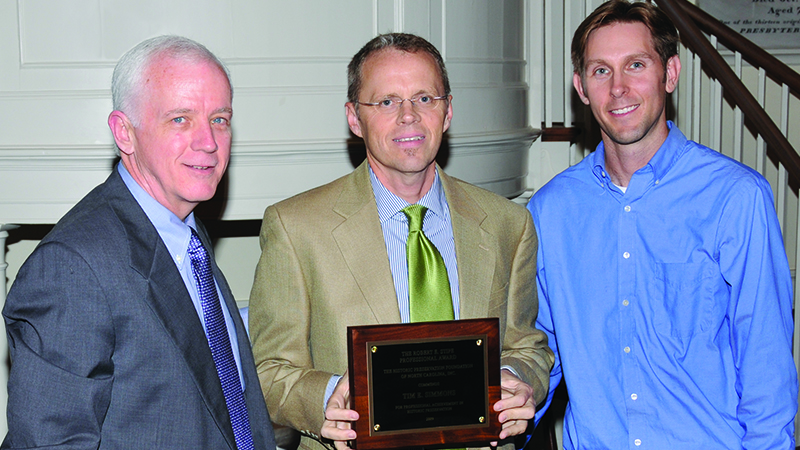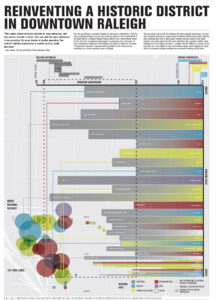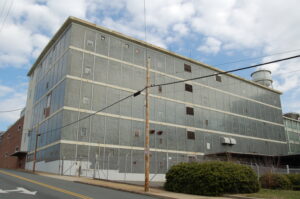The Impact and Importance of Preservation

Historic preservation in North Carolina creates jobs, fortifies the tax base, provides economic boosts to downtowns, and utilizes existing buildings and infrastructure while preserving the state’s priceless historic character. As a national leader among states in historic preservation efforts, North Carolina can boast a top five status in the federal historic rehabilitation tax credit program, bolstered by a robust parallel state tax credit program, both designed to foster investment in and preservation of endangered and underutilized historic properties. Alumnus Tim E. Simmons [BEDA ’81, B.Arch ’83] is key to the implementation and impact of these preservation projects as the Senior Preservation Architect and Income-Producing Tax Credit Coordinator with the NC State Historic Preservation Office. For more than 26 years, Simmons has held this position. “It’s a rewarding job, and I love it,” he states emphatically.
To date, approximately 3,500 buildings and homes have taken advantage of these preservation tax credits with an investment of $2.2 billion dollars. Ninety of the 100 counties in NC have participated. “Some towns use it very well, and it can be a great economic boost to downtowns,” states Simmons. He discloses that towns like Wilmington, Raleigh, Durham, Greensboro, Winston-Salem, Salisbury, Charlotte, and Asheville have used this program successfully. The historic tobacco warehouses have generated a great deal of attention and acclaim through rehabilitation.
“It’s amazing to see the American Tobacco Historic District in Durham 20 years ago, abandoned and underutilized, and to see it now. This is what [tax credits] can do for a community, city, or town. This area in Durham is so revitalized.”
Below are two income-producing historic tax credit projects that Simmon’s office reviewed and approved the Historic Preservation Certification Applications and provided historic rehabilitation advice and consultation.
First Example : Randolph County, Asheboro, Cranford Industries Office: The 1925 Cranford Industries Office for the Asheboro Hosiery Mills-Cranford Furniture Company was rehabilitated 2012-2013 and is now a successful bakery and restaurant. This project was spurred by the use of the federal and state historic income-producing tax credits with a private investment rehabilitation cost of $298,000.
Second Example: Wilkes County, Wilkesboro, Wilkesboro Elementary School: The 1937 Wilkesboro Elementary School located in the Downtown Wilkesboro Historic District was rehabilitated 2011-2012 into affordable housing for the elderly and disabled. The project utilized federal and state income-producing historic tax credits with a private investment rehabilitation cost of $1,784,000.
Simmons adds that Greg Hatem [NCSU Alumnus], a local developer who has been described as “the godfather of downtown Raleigh’s renaissance,” has purchased more than 40 buildings in downtown Raleigh with the intent of preserving the local character. “He has started restaurants such as Raleigh Times, Morning Times, Empire Eats, and Sitti. He’s done a lot of development, so it’s not a tear-down—it becomes a new kind of building by preserving the character of the built environment and not displacing tenants.”
After college, Simmons went to work for HagerSmith Design PA in Raleigh and Atlanta, where he worked on projects that included new office space, multi-use flex space, and preservation. It was here that his interest in preservation was piqued. When the architect working at the NC State Historic Preservation Office was reaching retirement, Simmons was encouraged to apply. “I decided to try it out. I had such an interest in the built environment and to preserve it as opposed to creating more sprawl, especially in urban areas.” His original intent was to stay for a few years to acquire some experience, but that has turned into almost three decades.
Below are two additional income-producing historic tax credit projects.
First Example : Durham County, Durham, Hill Building:
The 1937 Hill Building is an Art Deco 17-story skyscraper designed by the New York architectural firm of Shreve, Lamb, and Harmon who were famous for their 1931 Empire State Building; the local architect was George Watts Carr who designed the building’s interior and coordinated construction with building contractor George W. Kane. This highly significant former bank, commercial, and office building in the Downtown Durham Historic District was rehabilitated 2013-2015 for a creative new use as an innovative 21c Museum Hotel. This project was spurred by the use of the federal and state income-producing historic tax credits with a private investment rehabilitation cost of $38,000,000.
Second Example: Forsyth County, Winston-Salem, R.J. Reynolds Tobacco Company Factories 90 and 91: Wexford Science and Technology has redeveloped two former R. J. Reynolds Tobacco Factories 90 and 91 into a world-class research and innovation center consisting of office, retail, educational, technology, and state-of-the-art laboratory space. Tenants include the Wake Forest School of Medicine and Baptist Medical Center, the corporate headquarters for Inmar, Inc., Forsyth Technical Community College, a branch of the YMCA, and numerous private companies. Spurred by the use of the federal historic and state mill income-producing historic tax credits, this 2010-2015 project is the largest rehabilitation tax credit project in North Carolina to date with a total investment of $220.4 million.
Simmons manages the federal and state tax credit rehabilitation program, working with those who purchase properties that meet historic preservation requirements. He collaborates and consults on the designs so that developers and architects accurately accommodate the codes and regulatory needs of historic properties to ensure that the historic character is maintained. A benefit that Simmons emphasizes is that “developers who successfully rehabilitate these historic properties are eligible for tax credits. The tax credits [if using federal and state programs] can vary between 20 to 60 percent of the rehabilitation expenses, and therefore they can recuperate much of the costs.”
The tax credit is a reduction in the federal and state income tax owed, and therefore it doesn’t require actual funding. “The loss of revenue from these tax credits is outweighed by the economic benefit it provides a community,” Simmons explains. Many of the projects take vacant and dilapidated spaces and revitalize the area through the introduction of mixed-use buildings. “The local benefits of [the program] include construction jobs, new business opportunities, and the preservation of the built environment.” He continues, “What makes these towns and communities so special is the look and feel and the local character and flavor of the community, and it is worth preserving.”
Simmons remains connected to the College and has for many years been a visiting lecturer for courses that focus on preservation in the built environment. He first assisted with then-Professor Emeritus Robert P. Burns, FAIA, by speaking to students about preservation and the importance of maintaining the integrity and character of the building and community. He now provides similar expertise to Professor of the Practice Rodney Swink, FASLA, PLA, for LAR 582, a graduate-level landscape architecture special topics course, by educating students on the value of land preservation in collaboration with the built environment. Swink appreciates the importance of historic preservation: “It [has] a remarkable economic impact across NC, in the small towns and not just the big cities.” He is an expert himself on this topic, having directed the North Carolina Main Street program for 24 years. He knows first-hand the issues facing not only cities and towns but also community organizations concerned about growth and development.
Another way Simmons collaborates with the College is through student internships that he believes are a great way to influence and educate the designers of tomorrow. Current M.Arch student Kelsey Morrison is interning with Simmons, who shares how she has had the opportunity to meet with developers across the country and firms who focus on preservation. “It’s great for her to get this type of exposure,” Simmons emphasizes. Morrison has the highest regard for Simmons and loves the opportunity: “Tim [Simmons] has helped me take two of my passions, architecture and historic preservation, and focus them into one. Through working for him, Tim has given me the opportunity to develop my skills and learn so many new things I hope to use in my future career.”
- Categories:








